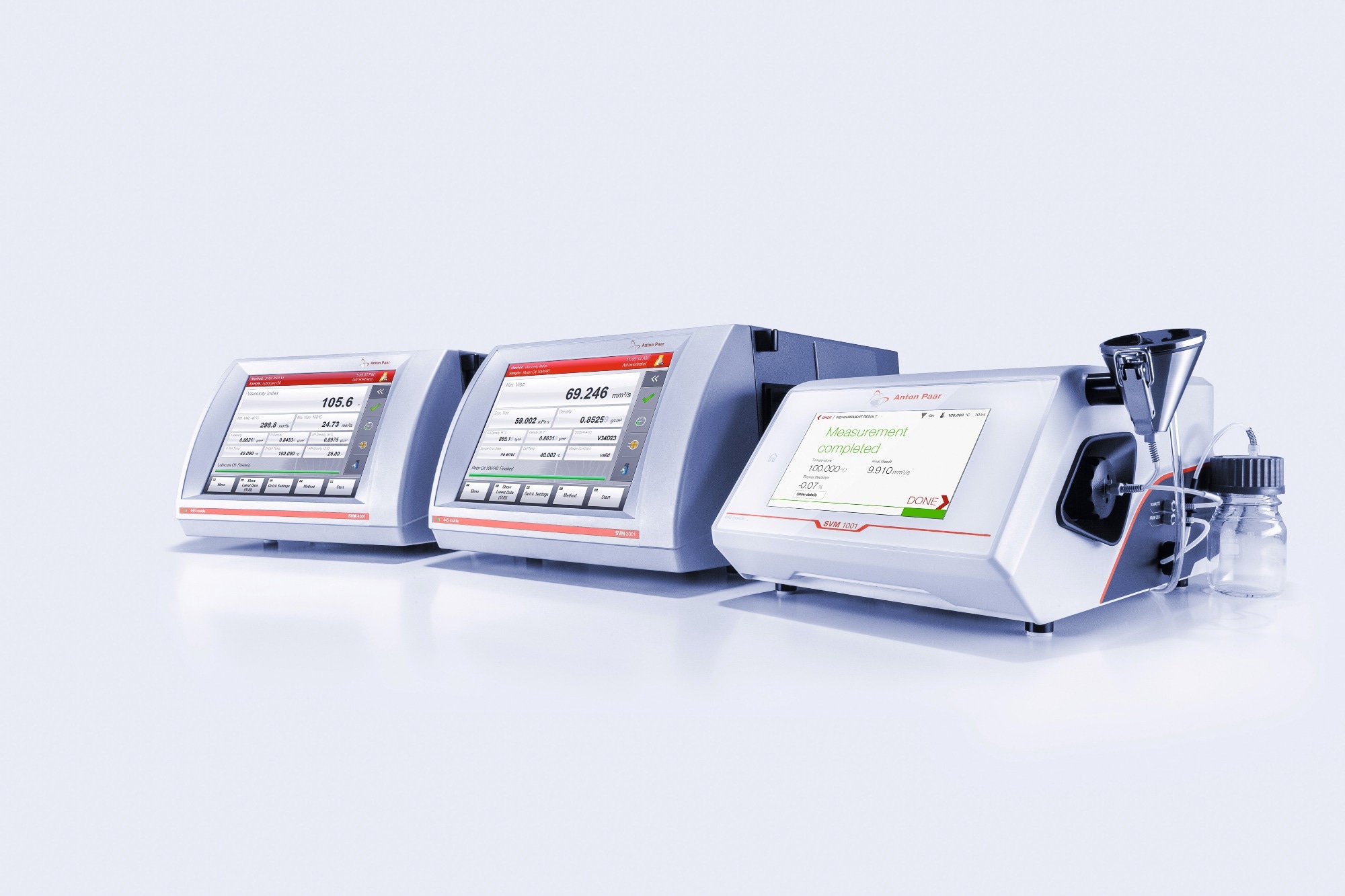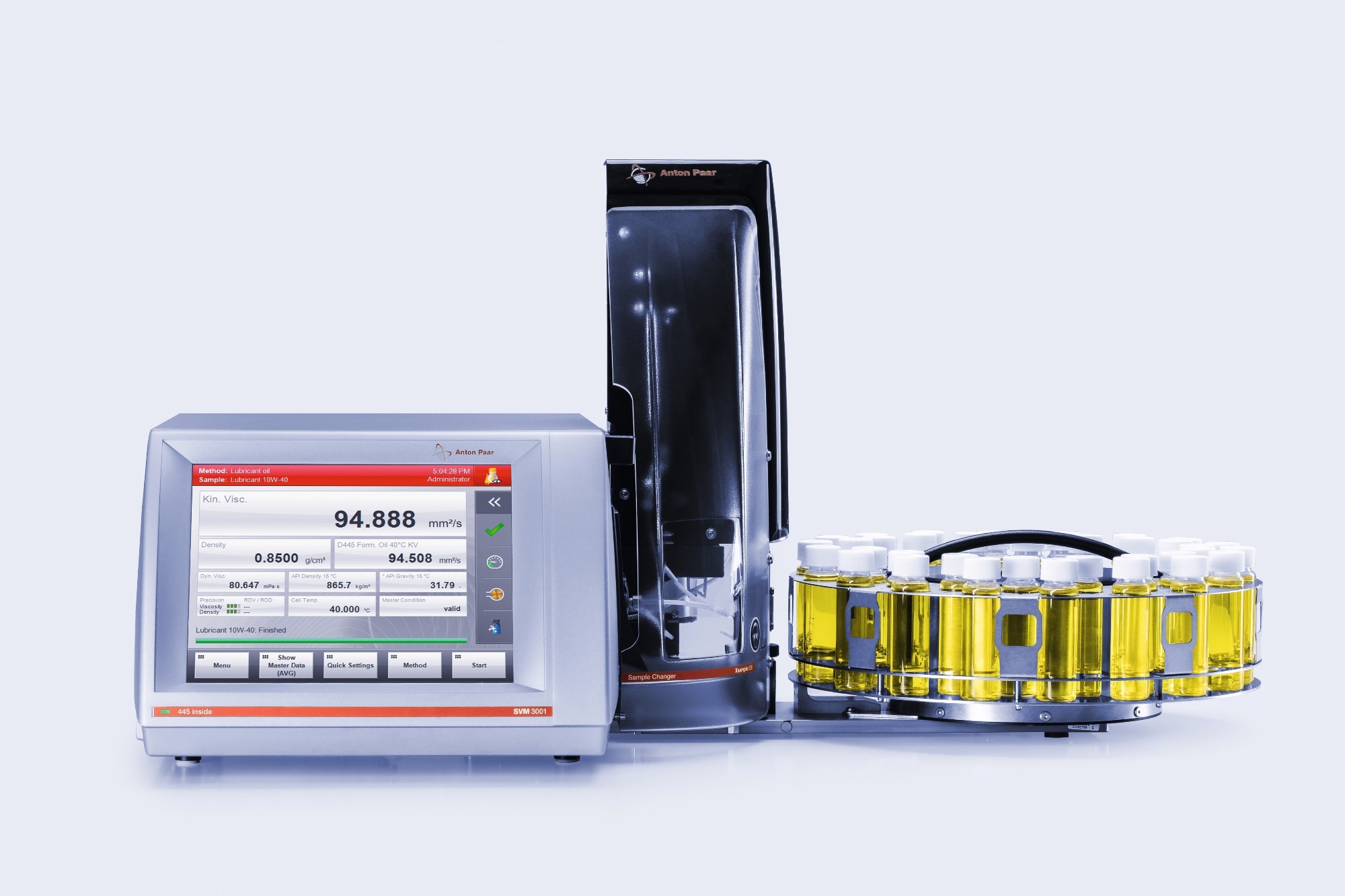In this interview, Anton Paar’s SVM viscometers take center stage as a prime example of innovation in laboratory technology.
Anton Paar has a long-standing reputation for precision instrumentation. Can you give us a brief overview of the company’s expertise in viscometry and how the SVM series fits into its broader portfolio?
Anton Paar is well known for its expertise in high-precision viscosity measurement, offering a broad range of instruments that include rotational and rolling-ball viscometers, as well as dynamic shear rheometers.
Building on this foundation, the SVM series delivers fast, accurate kinematic viscosity and density measurements in a single run. With test methods fully recognized by both ASTM and ISO standards, the SVM series offers a reliable and efficient solution for a variety of applications, including those in the petroleum and chemical industries and research and development.
What makes SVM unique compared to other viscometers in the industry?
The SVM series distinguishes itself through its broad measurement capabilities, high efficiency, and full compliance with industry standards. The SVM 3001, for example, covers a viscosity range from 0.2 mm2/s to 30,000 mm2/s and a temperature range from -60 °C to +135 °C - all within a single measuring cell. This eliminates the need for multiple capillaries and streamlines the testing process. It simultaneously measures kinematic viscosity, dynamic viscosity, and density, with optional calculations for parameters like viscosity index, API grades, Saybolt viscosity, and, in a specialized model, even cloud and freeze points.
Thanks to fast thermoelectric temperature control, the SVM enables rapid measurements without requiring external temperature baths. Fully compliant with ASTM D7042 and referenced in nearly all key petroleum industry standards, the SVM series provides an efficient and widely accepted alternative to traditional methods.
What are the main benefits of Anton Paar’s SVM series compared to traditional glass capillary viscometers?
Traditional glass capillary viscometers, compliant with ASTM D445, come with several limitations that make viscosity testing both time-consuming and resource-intensive. These instruments measure only kinematic viscosity, requiring additional tools or calculations for other key parameters like density or viscosity index. Each capillary is limited to a narrow viscosity range, so labs must maintain and regularly calibrate multiple capillaries to handle different sample types.
Managing these capillaries, along with tracking calibration records, adds unnecessary complexity to quality control and audit processes. Temperature changes are another challenge, often requiring lengthy stabilization times and re-calibration.
The SVM series addresses these issues with a single-instrument solution that measures multiple parameters simultaneously and covers a wide viscosity range in one measuring cell. Instead of relying on external temperature baths and long equilibration times, SVM uses thermoelectric temperature control for rapid stabilization. It also minimizes solvent use, requiring just 1.5 mL of sample and solvent, compared to the 12 to 20 mL, or even up to 100 mL of solvent needed for traditional methods.
With digital data storage and automated workflows, the SVM streamlines compliance, traceability, and everyday lab operations, making it a more efficient and practical choice for modern laboratories.

Image Credits: Anton Paar
Throughput and efficiency are crucial factors in laboratory settings. How do Anton Paar’s SVM viscometers influence productivity and overall performance?
Our SVM viscometers boost throughput by up to 150 % compared to traditional glass capillary viscometers, primarily thanks to significantly faster thermal equilibration. While glass capillary systems often rely on temperature baths with equilibration times of up to 30 minutes, the SVM uses thermoelectric temperature control to stabilize measurement conditions in one minute or less. This speed is further supported by the instrument’s low sample volume, which reaches the target temperature much faster than in conventional setups, and by shorter cleaning and drying times.
Models like the SVM 4001 take efficiency even further by determining the viscosity index (VI) in a single measurement. Instead of performing separate tests at 40 °C and 100 °C, the SVM 4001 analyzes the same sample simultaneously at both temperatures and calculates the VI automatically, eliminating the need for multiple runs.
Together, these features streamline workflows, reduce downtime between measurements, and significantly improve overall efficiency in the lab.
Automation is becoming increasingly important in laboratory workflows. How does automation in Anton Paar’s SVM viscometers improve accuracy and reduce operator workload?
Automation in Anton Paar’s SVM viscometers helps reduce costs, boost productivity, and eliminate handling errors. With automated operation, measurements can run unattended overnight or on weekends, maximizing instrument utilization and lowering the cost per test. This frees up lab personnel to focus on higher-value tasks, improving overall productivity.
Automation also ensures consistent, user-independent sample filling and supports automated cleaning through predefined workflows, reducing the risk of human error and ensuring repeatable, reliable results. For even greater efficiency, optional autosamplers can process up to 71 samples without operator intervention.
These capabilities make the SVM series a smart, dependable choice for high-throughput laboratories looking to streamline operations and maintain high-quality standards.
Solvent consumption and energy efficiency are becoming increasingly important in modern laboratories. How do Anton Paar’s SVM series compare to other viscometers in terms of sustainability and cost savings?
Anton Paar’s SVM series delivers notable advantages in both solvent consumption and energy efficiency compared to even automated D445 glass capillary viscometers. While automated D445 systems are more efficient than manual ones, they still typically use 12 to 20 mL of solvent per measurement. In contrast, the SVM requires just 1.5 mL, reducing solvent use by up to 90 % and significantly lowering both purchasing and disposal costs.
Energy consumption is another key differentiator. Automated D445 systems depend on temperature baths that consume over 1000 W of power. SVM units, however, use integrated thermoelectric temperature control, with some models operating on as little as 50 W, cutting energy use by more than 95 %.
These substantial reductions in solvent waste and power consumption not only help lower day-to-day operational costs but also support laboratories in meeting their sustainability goals.

Image Credits: Anton Paar
Anton Paar highlights the ability of SVM instruments to provide kinematic viscosity measurements using ASTM D7042 and bias-corrected D445. What are the practical implications of this dual capability for users?
SVM instruments offer kinematic viscosity measurements compliant with ASTM D7042 and ASTM-approved bias-corrected results equivalent to D445, bringing clear practical advantages. While ASTM D7042 is widely recognized, some industry specifications still require results based on the older ASTM D445 method. With SVM, users can generate results according to D7042 and automatically apply bias correction formulas to obtain D445-equivalent values, ensuring compliance without the need for separate D445 instruments.
This dual capability reduces equipment costs, simplifies maintenance, and streamlines lab operations. It also supports smooth integration into existing quality control processes, preserving comparability with historical data and maintaining consistency across long-term testing programs.
Safety is a crucial factor in laboratory operations. What specific safety advantages do Anton Paar’s SVM viscometers offer compared to traditional glass capillary-based viscometers?
Anton Paar’s SVM viscometers provide several important safety advantages over traditional glass capillary systems. The metal measuring cell eliminates the risk of glass breakage, reducing both the chance of injury and instrument downtime. Unlike capillary-based setups that often require handling flammable or toxic bath liquids, the SVM uses integrated thermoelectric temperature control - removing the need for hazardous substances altogether.
Its low solvent requirements further minimize exposure to harmful chemicals and reduce disposal risks. Automated sample filling and cleaning also limit direct operator contact with solvents and samples, enhancing overall lab safety. These features make the SVM a safer, more user-friendly solution for viscosity testing, protecting both personnel and the laboratory environment.
How does Anton Paar ensure that its viscometers remain compliant with evolving international standards, such as ASTM, ISO, and SAE specifications?
We ensure that our viscometers remain fully compliant with evolving international standards by actively participating in ASTM, ISO, and SAE committees. Experts from our viscometry product line serve as delegates within these organizations, directly contributing to the development and revision of key industry standards. This active involvement allows Anton Paar to stay ahead of regulatory changes and ensure that SVM viscometers are consistently aligned with the latest specifications.
In addition, all instruments are continuously validated against newly published standards to guarantee ongoing compliance with industry requirements.
In which industries do you see the biggest shift from traditional D445 viscometry to D7042-based testing, and what is driving this transition?
The petroleum industry is increasingly shifting from traditional D445 viscometry to D7042-based testing, with growing adoption across quality control departments in lubricant blending facilities, refineries, and testing laboratories. While SVM viscometers have long been trusted in R&D environments, their advantages in throughput, automation, and resource efficiency are now driving broader use in QC settings.
A major factor behind this transition is the widespread inclusion of D7042 in international specifications, enabling QC labs to remain fully compliant while benefiting from faster, more efficient testing. SVM also removes the limitations of temperature baths and reduces handling risks, offering a safer and more practical solution for routine viscosity measurement.
As the industry continues to prioritize cost efficiency, sustainability, and alignment with evolving standards, the adoption of D7042 in QC environments is expected to accelerate.
Anton Paar’s SVM viscometers are used in a variety of applications, from petroleum testing to food-grade lubricants. How does their compliance with multiple standards benefit customers across different industries?
Anton Paar’s SVM viscometers comply with more than 50 international standards, making them especially valuable in the petroleum industry, where adherence to ASTM, ISO, and SAE specifications is critical. With ASTM D7042 as the primary method - and the added ability to report bias-corrected D445 values - refineries, lubricant blenders, and testing laboratories can meet regulatory requirements while benefiting from faster, more efficient measurements. This dual compatibility supports seamless integration into existing QC workflows and eliminates the need for multiple instruments to satisfy different standards.
Strict standards compliance is generally less common outside the petroleum sector, except in the pharmaceutical industry. Here, SVM viscometers meet the requirements of USP Chapter 912 and EU Pharmacopoeia 2.2.10 for viscosity and USP 841 and Ph. Eur. 2.2.5 for density. This makes them well-suited for pharmaceutical QC environments where regulatory compliance is essential.
About Wolfgang Jud
Wolfgang Jud, PhD, is a Global Product Manager at Anton Paar GmbH, responsible for the strategic development of the SVM viscometer series. He translates customer needs, market research, and competitive analysis into actionable input for product development and portfolio planning. In this cross-functional role, he collaborates closely with R&D, marketing, application specialists, and global sales teams, driving product launches, training initiatives, and customer engagement worldwide. He also represents Anton Paar in international standards organizations such as ASTM, ISO, and Austrian Standards.
Dr. Jud earned his PhD in Electroorganic Chemistry from the University of Graz. He holds both a Master’s and Bachelor’s degree in Chemistry from Graz University of Technology.

This information has been sourced, reviewed and adapted from materials provided by Anton Paar GmbH.
For more information on this source, please visit Anton Paar GmbH.
Disclaimer: The views expressed here are those of the interviewee and do not necessarily represent the views of AZoM.com Limited (T/A) AZoNetwork, the owner and operator of this website. This disclaimer forms part of the Terms and Conditions of use of this website.